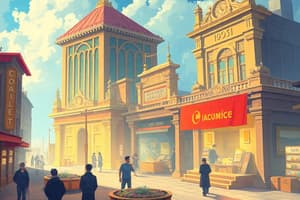Podcast
Questions and Answers
In a perfectly competitive market, what condition must hold true in the long-run equilibrium?
In a perfectly competitive market, what condition must hold true in the long-run equilibrium?
- Price is greater than both marginal cost and average total cost.
- Price is equal to marginal cost but greater than average total cost.
- Price is less than both marginal cost and average total cost.
- Price is equal to marginal cost and average total cost. (correct)
Why can monopolies potentially earn economic profits in the long run, unlike firms in perfectly competitive markets?
Why can monopolies potentially earn economic profits in the long run, unlike firms in perfectly competitive markets?
- Monopolies are forced to produce at the allocatively efficient quantity.
- Monopolies have lower marginal costs than competitive firms.
- Monopolies face a perfectly elastic demand curve.
- Monopolies benefit from high barriers to entry, preventing new firms from competing away profits. (correct)
What distinguishes an oligopoly from other market structures?
What distinguishes an oligopoly from other market structures?
- Firms act independently without considering rivals' actions.
- A single firm controls the market.
- A few large firms dominate the market and are mutually interdependent. (correct)
- There are no barriers to entry or exit.
What is the likely outcome in a 'tragedy of the commons' scenario?
What is the likely outcome in a 'tragedy of the commons' scenario?
A firm is maximizing total revenue. At what point on its marginal revenue curve is it operating?
A firm is maximizing total revenue. At what point on its marginal revenue curve is it operating?
In the context of game theory, what does a 'dominant strategy' refer to?
In the context of game theory, what does a 'dominant strategy' refer to?
If a market is experiencing a negative externality, how might a Pigouvian tax be used to improve efficiency?
If a market is experiencing a negative externality, how might a Pigouvian tax be used to improve efficiency?
Which of the following is the correct way to describe a Nash Equilibrium?
Which of the following is the correct way to describe a Nash Equilibrium?
What is a key difference between public goods and common resources in terms of excludability and rivalry?
What is a key difference between public goods and common resources in terms of excludability and rivalry?
Which of the following conditions would indicate that a firm should continue to produce in the short run, even if it is incurring losses?
Which of the following conditions would indicate that a firm should continue to produce in the short run, even if it is incurring losses?
In a monopoly, at what quantity and price does allocative efficiency occur?
In a monopoly, at what quantity and price does allocative efficiency occur?
What is the primary reason for allocative inefficiency in a monopoly compared to perfect competition?
What is the primary reason for allocative inefficiency in a monopoly compared to perfect competition?
What is the free-rider problem, and which type of good does it typically affect?
What is the free-rider problem, and which type of good does it typically affect?
In an oligopoly, firms often engage in strategic behavior. What does 'strategic behavior' typically involve?
In an oligopoly, firms often engage in strategic behavior. What does 'strategic behavior' typically involve?
How is the market supply curve derived in a perfectly competitive industry?
How is the market supply curve derived in a perfectly competitive industry?
How do patents impact market dynamics, and in which market structure are they most relevant?
How do patents impact market dynamics, and in which market structure are they most relevant?
What is the consequence of allocative inefficiency?
What is the consequence of allocative inefficiency?
What is the key regulatory outcome when government regulators implement fair-return pricing for a monopoly?
What is the key regulatory outcome when government regulators implement fair-return pricing for a monopoly?
What is the primary goal of a Pigouvian tax?
What is the primary goal of a Pigouvian tax?
How do high barriers to entry affect the market dynamics in an oligopoly?
How do high barriers to entry affect the market dynamics in an oligopoly?
Flashcards
Perfect Competition Characteristics
Perfect Competition Characteristics
Many firms sell identical products; no barriers to entry/exit; firms are price takers; economic profits only in the short run.
Short-run vs. Long-run (Perfect Competition)
Short-run vs. Long-run (Perfect Competition)
In the short run, firms can experience profits or losses, while in the long run, entry and exit of firms lead to zero economic profits.
Shutdown Rule
Shutdown Rule
Continue production if price is greater than or equal to average variable cost (P ≥ AVC).
Monopoly Characteristics
Monopoly Characteristics
Signup and view all the flashcards
Monopoly Profit Maximization
Monopoly Profit Maximization
Signup and view all the flashcards
Allocatively Efficient Output
Allocatively Efficient Output
Signup and view all the flashcards
Oligopoly Characteristics
Oligopoly Characteristics
Signup and view all the flashcards
Dominant Strategy
Dominant Strategy
Signup and view all the flashcards
Nash Equilibrium
Nash Equilibrium
Signup and view all the flashcards
Externalities
Externalities
Signup and view all the flashcards
Pigovian Tax
Pigovian Tax
Signup and view all the flashcards
Public Goods
Public Goods
Signup and view all the flashcards
Free-Rider Problem
Free-Rider Problem
Signup and view all the flashcards
Common Resources
Common Resources
Signup and view all the flashcards
Tragedy of the Commons
Tragedy of the Commons
Signup and view all the flashcards
Marginal Revenue
Marginal Revenue
Signup and view all the flashcards
Marginal Cost
Marginal Cost
Signup and view all the flashcards
Average Total Cost
Average Total Cost
Signup and view all the flashcards
Price Taker
Price Taker
Signup and view all the flashcards
Price Maker
Price Maker
Signup and view all the flashcards
Study Notes
Perfect Competition
- Features identical products and no entry or exit barriers.
- Firms operate as price takers.
- Economic profits exist only temporarily.
- Long-run profits are normal (zero economic profit).
- Agricultural markets exemplify this structure.
- Companies may profit or loss in the short run
- Entry and exit ensure zero economic profits in the long run.
- The marginal cost curve above AVC is the firm's short-run supply curve.
- The market supply curve sums all firms' supply (MC) curves horizontally.
- Marginal Revenue equals Price.
- Profit maximization occurs where MR = MC.
- Shutdown if P ≥ AVC.
- Long-run equilibrium is where P = MC = ATC.
Monopoly
- A single firm dominates, with high entry barriers like patents.
- The firm sets prices.
- Sustained economic profits are possible due to barriers.
- Marginal Revenue is less than Price because of downward-sloping demand.
- Profit is maximized at Q where MR = MC, but P > MC.
- Total Revenue is maximized at Q when MR=0
- Fair return pricing is at Q where P = ATC.
- Allocative efficiency happens at Q where P=MC.
- Allocative inefficiency causes deadweight loss.
- The marginal cost curve above AVC functions as the firms short run supply curve.
Oligopoly
- A few large firms control the market.
- Entry barriers are significant.
- Firms are mutually interdependent.
- Strategic behavior uses game theory.
- A dominant strategy is the best action, regardless of the opponent's choice.
- A non-dominant strategy relies on an opponent's choice.
- Nash equilibrium means no firm wants to alter its strategy alone.
Externalities
- Positive externalities include education and vaccinations.
- Negative externalities include pollution and noise.
- Governments use taxes (Pigovian tax) for negative externalities.
- Subsidies support positive externalities.
- Regulations correct market failures.
Public Goods and Common Resources
- Public goods are non-rival and non-excludable, like fireworks.
- Public goods face the free-rider problem.
- Common resources are rival but non-excludable, like overfishing.
- This leads to the "Tragedy of the Commons".
Graphical Analysis
- Identify output choices on graphs.
- Compare monopolies and perfect competition visually.
- Find profit or loss areas.
- Interpret MC, ATC, and MR curves.
Sample Concepts/Terms
- Marginal Revenue
- Marginal Cost
- Average Total Cost
- Price Taker versus Price Maker
- Deadweight Loss
- Allocative and Productive Efficiency
- Free-Rider Problem
- Tragedy of the Commons
- Pigovian Taxes
- Dominant Strategy
- Nash Equilibrium
Studying That Suits You
Use AI to generate personalized quizzes and flashcards to suit your learning preferences.




